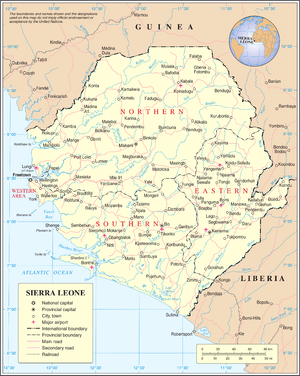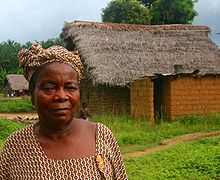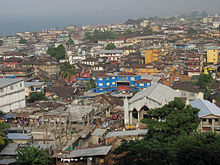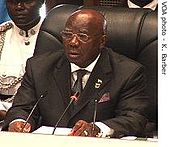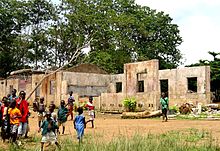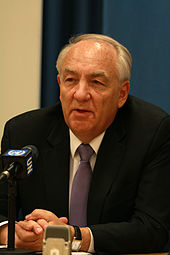- Sierra Leone Civil War
-
Sierra Leone Civil War
Map of Sierra LeoneDate 23 March 1991 – 18 January 2002 Location Sierra Leone Result Government victory Belligerents  Sierra Leone
Sierra Leone
 Kamajors
Kamajors
Executive Outcomes (South Africa-based mercenary group)
 Nigerian-led ECOMOG forces
Nigerian-led ECOMOG forces
 United Nations Mission to Sierra Leone
United Nations Mission to Sierra Leone
 United Kingdom
United Kingdom RUF
RUF
 NPFL
NPFL
AFRC
West Side BoysCommanders and leaders  Ahmad Tejan Kabbah
Ahmad Tejan Kabbah
 Samuel Hinga Norman
Samuel Hinga Norman
 Valentine Strasser
Valentine Strasser
 Solomon Musa
Solomon Musa
 David J. Richards
David J. Richards
 Tony Blair
Tony Blair Foday Sankoh
Foday Sankoh
 Johnny Paul Koroma
Johnny Paul Koroma
 Sam Bockarie
Sam Bockarie
 Foday Kallay
Foday Kallay
 Charles Taylor
Charles TaylorCasualties and losses Upwards of 50,000 Sierra Leoneans[1]
2.5 million displaced internally and externally[1]The Sierra Leone Civil War (1991-2002) began on 23 March 1991 when the Revolutionary United Front (RUF), with support from the special forces of Charles Taylor’s National Patriotic Front of Liberia (NPFL), intervened in Sierra Leone in an attempt to overthrow the Joseph Momoh government. The resulting civil war lasted 11 years, enveloped the country, and left over 50,000 dead.[1]
During the first year of the war, the RUF took control of large swathes of territory in eastern and southern Sierra Leone, which were rich in alluvial diamonds. The government's ineffective response to the RUF, and the disruption in government diamond production, precipitated a military coup d'état in April 1992 by the National Provisional Ruling Council (NPRC).[2] By the end of 1993, the Sierra Leone Army (SLA) had succeeded in pushing the RUF rebels back to the Liberian border, but the RUF recovered and fighting continued. In March 1995, Executive Outcomes (EO), a South Africa-based private military company, was hired to repel the RUF. Sierra Leone installed an elected civilian government in March 1996, and the retreating RUF signed the Abidjan Peace Accord. Under UN pressure, the government terminated its contract with EO before the accord could be implemented, and hostilities recommenced.[3][4]
In May 1997 a group of disgruntled SLA officers staged a coup and established the Armed Forces Revolutionary Council (AFRC) as the new government of Sierra Leone.[5] The RUF joined with the AFRC to capture Freetown with little resistance. The new government, led by Johnny Paul Koroma, declared the war officially over. A wave of looting, rape, and murder followed the announcement.[6] Reflecting international dismay at the overturning of the civilian government, ECOMOG forces intervened and retook Freetown on behalf of the government, but they found the outlying regions more difficult to pacify.
In January 1999, world leaders intervened diplomatically to promote negotiations between the RUF and the government.[7] The Lome Peace Accord, signed on 27 March 1999, was the result. Lome gave Foday Sankoh, the commander of the RUF, the vice presidency and control of Sierra Leone's diamond mines in return for a cessation of the fighting and the deployment of a UN peacekeeping force to monitor the disarmament process. RUF compliance with the disarmament process was inconsistent and sluggish, and by May 2000, the rebels were advancing again upon Freetown.[8] The British intervened to save the failing UN mission and the weak government of President Ahmad Tejan Kabbah. With help from a renewed UN mandate and Guinean air support, the British Operation Palliser finally defeated the RUF. On 18 January 2002, President Kabbah declared the Sierra Leone Civil War officially over.
Contents
The BBS
SLA response; Sobels
The initial rebellion could have easily been quelled in the first half of 1991. But the RUF – despite being both numerically inferior and extremely brutal against civilians – controlled two-thirds of Sierra Leone by the year’s end. The SLA’s equally poor behavior made this outcome possible.[9] Often afraid to directly confront or unable to locate the elusive RUF, government soldiers were brutal and indiscriminate in their search for rebels or sympathizers among the civilian population. After retaking captured towns, the SLA would perform a ‘mopping up’ operation in which the towns people were transported to concentration camp styled ‘strategic hamlets’ far from their homes in Eastern and Southern Sierra Leone under the pretense of separating the population from the insurgents. However in many cases, this was followed by much looting and theft after the villagers were evacuated.[10]
The SLA's sordid behavior inevitably led to the alienation of many civilians and pushed some Sierra Leoneans to join the rebel cause. With morale low and rations even lower, many SLA soldiers discovered that they could do better by joining with the rebels in looting civilians in the countryside instead of fighting against them.[6] The local civilians referred to these soldiers as ‘sobels’ or ‘soldiers by day, rebels by night’ because of their close ties to the RUF. By mid-1993, the two opposing sides became virtually indistinguishable. For these reasons, civilians increasingly relied on an irregular force called the Kamajors for their protection.[11]
Rise of the Kamajors
Main article: KamajorsA grassroots militia force, the Kamajors operated invisibly in familiar territory and was a significant impediment to marauding government and RUF troops.[12] For displaced and unprotected Sierra Leonans, joining the Kamajors was a means of taking up arms to defend family and home due to the SLA’s perceived incompetence and active collusion with the rebel enemy. The Kamajors clashed with both government and RUF forces and was instrumental in countering government soldiers and rebels who were looting villages.[13] The success of the Kamajors raised calls for its expansion, and members of street gangs and deserters were also co-opted into the organization. However, the Kamajors became corrupt and deeply involved in extortion, murder, and kidnappings by the end of the conflict.[14]
National Provisional Ruling Council
Within one year of fighting, the RUF offensive had stalled, but it still remained in control of large territories in Eastern and Southern Sierra Leone leaving many villages unprotected while also disrupting food and government diamond production. Soon the government was unable to pay both its civil servants and the SLA. As a result, the Momoh regime lost all remaining credibility and a group of disgruntled junior officers led by Captain Valentine Strasser overthrew Momoh on 29 April 1992.[2][15] Strasser justified the coup and the establishment of the National Provisional Ruling Council (NPRC) by referencing the corrupt Momoh regime and its inability to resuscitate the economy, provide for the people of Sierra Leone, and repel the rebel invaders. The NPRC’s coup was largely popular because it promised to bring peace to Sierra Leone.[16] But the NPRC’s promise would prove to be short lived.[17]
In March 1993, with much help from ECOMOG troops provided by Nigeria, the SLA recaptured the Koidu and Kono diamond districts and pushed the RUF to the Sierra Leone – Liberia border.[18] The RUF was facing supply problems as the United Liberation Movement of Liberia for Democracy (ULIMO) gains inside Liberia were restricting the ability of Charles Taylor’s NPFL to trade with the RUF. By the end of 1993, many observers thought that the war was over because for the first time in the conflict the Sierra Leone Army was able to establish itself in the Eastern and the Southern mining districts.[19]
However, with senior government officials neglectful of the conditions faced by SLA soldiers, front line soldiers became resentful of their poor conditions and began helping themselves to Sierra Leone’s rich natural resources.[20] This included alluvial diamonds as well as looting and ‘sell game’, a tactic in which government forces would withdraw from a town but not before leaving arms and ammunition for the roving rebels in return for cash.[9] Renegade SLA soldiers even clashed with Kamajor units on a number of occasions when the Kamajors intervened to halt the looting and mining. The NPRC government also had a motivation for allowing the war to continue, since as long as the country was at war the military government would not be called upon to hand over rule to a democratically-elected civilian government.[19] The war dragged on as a low intensity conflict until January 1995 when RUF forces and dissident SLA elements seized the SIEROMCO (bauxite) and Sierra Rutile (titanium dioxide) mines in the Moyamba and Bonthe districts in the country's south west, furthering the government’s economic struggles and enabling a renewed RUF advance on the capital at Freetown.[21]
Executive Outcomes
Main article: Executive OutcomesIn March 1995, with the RUF within twenty miles of Freetown, Executive Outcomes, a paramilitary group from South Africa, arrived in Sierra Leone. For $1.8 million per month (financed primarily by the International Monetary Fund), EO was paid to accomplish three goals: return the diamond and mineral mines to the government, locate and destroy the RUF’s headquarters, and operate a successful propaganda program that would encourage local Sierra Leoneans to support the government of Sierra Leone.[22] EO’s military force consisted of 500 military advisers and 3,000 highly trained and well-equipped combat-ready soldiers, backed by tactical air support and transport. Executive Outcomes employed black Angolans and Namibians from apartheid-era South Africa’s former 32 Battalion, with an officer corps of white South Africans.[23] Harper’s Magazine described this controversial unit as a collection of former spies, assassins, and crack bush guerrillas, most of whom had served for fifteen to twenty years in South Africa’s most notorious counter insurgency units.[24]
As a military force, EO was extremely skilled and conducted a highly successful counter insurgency against the RUF. In just ten days of fighting, EO was able to drive the RUF forces back sixty miles into the interior of the country.[23] EO outmatched the RUF forces in all operations. In just seven months, EO, with support from loyal SLA and the Kamajors battalions, recaptured the diamond mining districts and the Kangari Hills, a major RUF stronghold.[25] A second offensive captured the provincial capital and the largest city in Sierra Leone and destroyed the RUF’s main base of operations near Bo, finally forcing the RUF to admit defeat and sign the Abidjan Peace Accord in Abidjan, Côte d'Ivoire on 30 November 1996.[26] This period of relative peace also allowed the country to hold parliamentary and presidential elections in February and March 1996.[27] Ahmad Tejan Kabbah (of the Sierra Leone People's Party [SLPP]), a diplomat who had worked at the UN for more than 20 years, won the presidential election.[28]
Abidjan Peace Accord
Main article: Abidjan Peace AccordThe Abidjan Peace Accord mandated that Executive Outcomes was to pull out within five weeks after the arrival of a neutral peacekeeping force. The main stumbling block that prevented Sankoh from signing the agreement sooner was the number and type of peacekeepers that were to monitor the ceasefire.[7][29] Additionally, continued Kamajor attacks and the fear of punitive tribunals following demobilization kept many rebels in the bush despite their dire situation. However, in January 1997, the Kabbah government – beset by demands to reduce expenditures by the International Monetary Fund – ordered EO to leave the country, even though a neutral monitoring force had yet to arrive.[4][26] The departure of EO opened up an opportunity for the RUF to regroup for renewed military attacks.[4] The March 1997 arrest of RUF leader Foday Sankoh in Nigeria also angered RUF members, who reacted with escalated violence. By the end of March 1997, the peace accord had collapsed.[30]
AFRC/RUF coup and interregnum
Main article: Armed Forces Revolutionary CouncilAfter the departure of Executive Outcomes, the credibility of the Kabbah government declined, especially among members of the SLA, who saw themselves being eclipsed by both the RUF on one side and the independent but pro-government Kamajors on the other.[31] On 25 March 1997, a group of disgruntled SLA officers freed and armed 600 prisoners from the Pademba Road prison in Freetown. One of the prisoners, Major Johnny Paul Koroma, emerged as the leader of the coup and the Armed Forces Revolutionary Council (AFRC) proclaimed itself the new government of Sierra Leone.[5] After receiving the blessing of Foday Sankoh, who was then living under house arrest in Nigeria, members of the RUF – supposedly on its last legs – were ordered out of the bush to participate in the coup. Without hesitation and encountering only light resistance from SLA loyalists, 5,000 rag-tag rebel fighters marched 100 miles and overran the capital. Without fear or reluctance, RUF and SLA dissidents then proceeded to parade peacefully together. Koroma then appealed to Nigeria for the release of Foday Sankoh, appointing the absent leader to the position of deputy chairman of the AFRC.[32] The joint AFRC/RUF leadership then proclaimed that the war had been won, and a great wave of looting and reprisals against civilians in Freetown (dubbed "Operation Pay Yourself" by some of its participants) followed.[33][34] President Kabbah, surrounded only by his bodyguards, left by helicopter for exile in nearby Guinea.[35]
The AFRC junta was opposed by members of Sierra Leone's civil society such as student unions, journalists associations, women's groups and others, not only because of the violence it unleashed but because of its political attacks on press freedoms and civil rights.[36] The international response to the coup was also overwhelmingly negative.[37] The UN and the Organization of African Unity (OAU) condemned the coup, foreign governments withdrew their diplomats and missions (and in some cases evacuated civilians) from Freetown, and Sierra Leone's membership in the Commonwealth was suspended.[38] The Economic Community of West African States (ECOWAS) also condemned the AFRC coup, and ECOMOG forces demanded that the new junta return power peacefully to the Kabbah government or risk sanctions and increased military presence.[39]
ECOMOG’s intervention in Sierra Leone brought the AFRC/RUF rebels to the negotiating table where, in October 1997, they agreed to a tentative peace known as the Conakry Peace Plan.[40] Despite having agreed to the plan, the AFRC/RUF continued to fight. In March 1998, overcoming entrenched AFRC positions, the ECOMOG forces retook the capital and reinstated the Kabbah government, but let the rebels flee without further harassment.[41][42] The regions lying just beyond Freetown proved much more difficult to pacify. Thanks in part to bad road conditions, lack of support aircraft, and a revenge driven rebel force, ECOMOG’s offensive ground to a halt just outside Freetown. ECOMOG’s forces suffered from several weakness, the most important being, poor command and control, low morale, poor training in counterinsurgency, low manpower, limited air and sea capability, and poor funding.[citation needed]
In January 1999 the AFRC/RUF again set upon Freetown in a bloody assault known as "Operation No Living Thing" in which rebels entered neighborhoods to loot, rape and kill indiscriminately.[43] A Human Rights Watch report documented the atrocities committed during this attack. The report estimated that over 7,000 people were killed and that at least half of them were civilians.[44] Unable to consistently defend itself against the AFRC/RUF rebels, the Kabbah regime was forced to make serious concessions in the Lome Peace Agreement of July 1999.[45]
Lome peace agreement
Main article: Lome Peace AccordGiven that Nigeria was due to recall its ECOMOG forces without achieving a tactical victory over the RUF, the international community intervened diplomatically to promote negotiations between the AFRC/RUF rebels and the Kabbah regime.[46] The Lome Peace Accord, signed on 7 July 1999, is controversial in that Sankoh was pardoned for treason, granted the position of Vice President, and made chairman of the commission that oversaw Sierra Leone’s diamond mines.[47] In return, the RUF was ordered to demobilize and disarm its armies under the supervision of an international peacekeeping force which would initially be under the authority of both ECOMOG and the United Nations. The Lome Peace Agreement was the subject of protests both in Sierra Leone and by international human rights groups abroad, mainly because it handed over to Sankoh, the commander of the unimaginably brutal RUF, the second most powerful position in the country, and control over all of Sierra Leone’s lucrative diamond mines.[47]
DDR process
Main article: Disarmament, Demobilization and ReintegrationFollowing the Lome Peace Agreement, the security situation in Sierra Leone was still unstable because many rebels refused to commit themselves to the peace process.[7][48] The DDR camps were an attempt to convince the rebel forces to literally exchange their weapons for food, clothing, and shelter.[49] During a six week quarantine period, former combatants were taught basic skills that could be put to use in a peaceful profession after they return to society. After 2001, DDR camps became increasingly effective and by 2002 they had collected over 45,000 weapons and hosted over 70,000 former combatants.[50]
UNAMSIL intervention
Main article: UNAMSILIn October 1999 the UN established the United Nations Mission to Sierra Leone (UNAMSIL). The main objective of UNAMSIL was to assist with the disarmament process and enforce the terms established under the Lome Peace Agreement.[7] Unlike other previous neutral peacekeeping forces, UNAMSIL brought serious military power.[citation needed] The original multi-national force was commanded by General Vijay Jetley of India.[51] Jetley later resigned and was replaced by Lieutenant General Daniel Opande of Kenya in November 2000.[52]
UNAMSIL forces began arriving in Sierra Leone in December 1999. At that time the maximum number of troops to be deployed was set at 6,000. Only a few months later, though, in February 2000, a new UN resolution authorized the deployment of 11,000 combatants.[53] In March 2001 that number was increased to 17,500 troops, making it at the time the largest UN force in existence,[52] and UNAMSIL soldiers were deployed in the RUF-held diamond areas. Despite these numbers, UNAMSIL was frequently rebuffed and humiliated by RUF rebels, being subjected to attacks, obstruction and disarmament. In the most egregious example, in May 2000 over 500 UNAMSIL peacekeepers were captured by the RUF and held hostage. Using the weapons and armored personnel carriers of the captured UNAMSIL troops, the rebels advanced towards Freetown, taking over the town of Lunsar to its northeast.[8] For over a year later, the UNAMSIL force meticulously avoided intervening in RUF controlled mining districts lest another major incident occur.[54] After the UNAMSIL force had essentially rearmed the RUF, a call for a new military intervention was made to save the UNAMSIL hostages and the government of Sierra Leone.[citation needed]
Operation Palliser
In May 2000, the situation on the ground had deteriorated to such an extent that British Royal Marines were deployed in Operation Palliser to evacuate foreign nationals and establish order.[55] They stabilized the situation, and were the catalyst for a ceasefire that helped end the war. The British forces, under the command of Brigadier David Richards, expanded their original mandate which was limited to evacuating commonwealth citizens and now aimed to save UNAMSIL from the brink of collapse. At the time of the British intervention in May 2000, half of the country remained under the RUF’s control. The 1,200 man British ground force - supported by air and sea power - shifted the balance of power in favor of the government and the rebel forces were easily repelled from the areas beyond Freetown.[56]
End of the war
Several factors led to the end of the civil war. First, Guinean cross-border bombing raids against villages believed to be bases used by the RUF working in conjunction with Guinean dissidents were very effective in routing the rebels.[57][58] Another factor encouraging a less combative RUF was a new UN resolution that demanded that the government of Liberia expel all RUF members, end their financial support of the RUF, and halt the illicit diamond trade.[59] Finally, the Kamajors, feeling less threatened now that the RUF was disintegrating in the face of a robust opponent, failed to incite violence like they had done in the past. With their backs against the wall and without any international support, the RUF forces signed a new peace treaty within a matter of weeks.
On 18 January 2002, President Kabbah declared the eleven year long Sierra Leone Civil War officially over.[60] By most estimates, over 50,000 people had lost their lives during the war.[1][61] Countless more fell victim to the reprehensible and perverse behavior of the combatants. In May 2002 President Kabbah and his party, the Sierra Leone People's Party (SLPP), won landslide victories in the presidential and legislative elections. Kabbah was re-elected for a five year term. The RUF's political wing, the Revolutionary United Front Party (RUFP), failed to win a single seat in parliament. The elections were marked by irregularities and allegations of fraud, but not to a degree that significantly affected the outcome.[citation needed]
After the war
Withdrawal
On 28 July 2002 the British withdrew a 200-strong military contingent that had been in country since the summer of 2000, leaving behind a 140-strong military training team with orders to professionalize the SLA and Navy. In November 2002, UNAMSIL began a gradual reduction from a peak level of 17,800 personnel.[63] Under pressure from the British, the withdrawal slowed, so that by October 2003 the UNAMSIL contingent still stood at 12,000 men. As peaceful conditions continued through 2004, however, UNAMSIL drew down its forces to slightly over 4,100 by December 2004. The UN Security Council extended UNAMSIL’s mandate until June 2005 and again until December 2005. UNAMSIL completed the withdrawal of all troops in December 2005 and was succeeded by the United Nations Integrated Office in Sierra Leone (UNIOSIL).[64]
Truth and Reconciliation Commission
The Lome Peace Accord called for the establishment of a Truth and Reconciliation Commission to provide a forum for both victims and perpetrators of human rights violations during the conflict to tell their stories and facilitate healing. Subsequently, the Sierra Leonean government asked the UN to help set up a Special Court for Sierra Leone, which would try those who "bear the greatest responsibility for the commission of crimes against humanity, war crimes and serious violations of international humanitarian law, as well as crimes under relevant Sierra Leonean law within the territory of Sierra Leone since 30 November 1996." Both the Truth and Reconciliation Commission and the Special Court began operating in the summer of 2002.[65]
Diamond revenues
Diamond revenues in Sierra Leone have increased more than tenfold since the end of the conflict, from $10 million in 2000 to about $130 million in 2004, although according to the UNAMSIL surveys of mining sites, "more than 50 per cent of diamond mining still remains unlicensed and reportedly considerable illegal smuggling of diamonds continues".[63]
Prosecution
On 13 January 2003, a small group of armed men tried unsuccessfully to break into an armory in Freetown. Former AFRC-junta leader Koroma, after being linked to the raid, went into hiding. In March, the Special Court for Sierra Leone issued its first indictments for war crimes during the civil war. Foday Sankoh, already in custody, was indicted, along with notorious RUF field commander Sam "Mosquito" Bockarie, Koroma, the Minister of Interior and former head of the Civil Defense Force, Samuel Hinga Norman, and several others. Norman was arrested when the indictments were announced, while Bockarie and Koroma remained at large (presumably in Liberia). On 5 May 2003, Bockarie was killed in Liberia. President Charles G. Taylor expected to be indicted by the Special Court and had feared Bockarie’s testimony.[66] He is suspected of ordering Bockarie's murder, although no indictments are pending.[67]
Several weeks later, word filtered out of Liberia that Koroma had been killed as well, although his death remains unconfirmed. In June the Special Court announced Taylor’s indictment for war crimes.[68] Sankoh died in prison in Freetown on 29 July 2003 from a heart attack. He had been ailing for some time.[citation needed]
In August 2003 President Kabbah testified before the Truth and Reconciliation Commission on his role during the civil war. On 1 December 2003, Major General Tom Carew, who had been the Chief of Defence Staff for the Government of Sierra Leone and an important figure in the Sierra Leonean Army, was reassigned to civilian duties. In June 2007, the Special Court found three of the eleven people indicted – Alex Tamba Brima, Brima Bazzy Kamara and Santigie Borbor Kanu – guilty of war crimes, including acts of terrorism, collective punishments, extermination, murder, rape, outrages upon personal dignity, conscripting or enlisting children under the age of 15 years into armed forces, enslavement and pillage.[69]
Depictions
The civil war served as the background for the 2006 movie Blood Diamond, starring Leonardo DiCaprio, Djimon Hounsou and Jennifer Connelly.[70] During the end of the movie Lord of War, Yuri Orlov (played by Nicolas Cage) sells arms to militias during the civil war. The militias are allied with André Baptiste (Eamonn Walker), who is based on Charles Taylor.[71]
The use of children in both the rebel (RUF) military and the government militia is depicted in Ishmael Beah's 2007 memoir, A Long Way Gone. Mariatu Kamara wrote about being attacked by the rebels and having her hands chopped off in her book The Bite of the Mango. Ishmael Beah wrote a foreword to Kamara's book.[72]
The documentary movie Sierra Leone's Refugee All Stars tells the story of a group of refugees who fled to Guinea and created a band to ease the pain of the constant difficulty of living away from home and community after the atrocities of war and mutilation.[73]
References
- ^ a b c d Gberie, p. 6
- ^ a b Gberie, p. 103
- ^ Keen, p. 111
- ^ a b c Abdullah, p. 118
- ^ a b Abdullah, p.180
- ^ a b Gberie, p. 102
- ^ a b c d Gberie, p. 161
- ^ a b Abdullah, pp. 214–17
- ^ a b Abdullah, p. 106
- ^ Gberie, p. 127
- ^ Abdullah, p. 4
- ^ Gberie, p. 110
- ^ Abdullah, p. 168
- ^ Gberie, p. 134
- ^ Abdullah, p.105
- ^ Gberie, p. 72
- ^ Gberie, p. 74
- ^ Gberie, p. 65
- ^ a b Abdullah, p. 108
- ^ Gberie, p. 180
- ^ Gberie, pp. 106 and 88
- ^ Abdullah, p. 90
- ^ a b Gberie, p. 93
- ^ Gberie, p. 94
- ^ Abdullah, p. 96
- ^ a b Gberie, p. 95
- ^ "Elections in Sierra Leone". African Elections Database. 17 September 2007. http://africanelections.tripod.com/sl.html. Retrieved 24 December 2010.
- ^ Abdullah, p. 144
- ^ Abdullah, p. 206
- ^ "Chronology". Paying the price: The Sierra Leone peace process. Conciliation Resources. September 2000. http://www.c-r.org/our-work/accord/sierra-leone/chronology.php.
- ^ Abdullah, pp. 118-19
- ^ Allie, Joe (2005). "The Kamajor Militia in Sierra Leone: Liberators or Nihilists?". In Francis, David J.. Civil Militia: Africa's Intractable Security Menace?. Burlington, VT: Ashgate. p. 59
- ^ Abdullah, p. 148
- ^ Gberie, p. 107
- ^ Gberie, p. 108
- ^ Abdullah, p. 156
- ^ "The AFRC remained a pariah junta, shunned by every government in the world." Abdullah, p. 156
- ^ Abdullah, p. 158
- ^ Gberie, p. 112
- ^ Abdullah, p. 161
- ^ Abdullah, p. 223
- ^ Gberie, p. 121
- ^ Gberie, p. 125
- ^ "Getting Away with Murder, Mutilation, Rape: New Testimony from Sierra Leone". Human Rights Watch. July 1999. http://www.hrw.org/legacy/reports/1999/sierra/SIERLE99-03.htm. Retrieved December 26, 2010.
- ^ Abdullah, p. 212
- ^ Abdullah, p.199
- ^ a b Abdullah, p. 213
- ^ Abdullah, p.166
- ^ Gberie, p. 163
- ^ Gberie, p. 187
- ^ Gberie, p. 164
- ^ a b Malan, Mark, Phenyo Rakate and Angela MacIntyre (January 2002). "Chapter Four: The 'New' UNAMSIL: Strength and Composition". Peacekeeping in Sierra Leone: UNAMSIL Hits the Home Straight. Pretoria, South Africa: Institute for Security Studies. http://www.iss.co.za/pubs/monographs/No68/Chap4.html. Retrieved 29 December 2010.
- ^ Malan, Mark, Phenyo Rakate and Angela MacIntyre (January 2002). "Chapter Three: UNAMSIL's Troubled Debut". Peacekeeping in Sierra Leone: UNAMSIL Hits the Home Straight. Pretoria, South Africa: Institute for Security Studies. http://www.iss.co.za/pubs/monographs/No68/Chap3.html. Retrieved 29 December 2010.
- ^ Gberie, p. 189
- ^ Gberie, p. 173
- ^ Gberie, p. 176
- ^ Abdullah, p. 221
- ^ Gberie, p. 172
- ^ Gberie, p. 170
- ^ Abdullah, p. 229
- ^ Hirsch, p. 31
- ^ "Sierra Leone". 2001 Findings on the Worst Forms of Child Labor. Bureau of International Labor Affairs, U.S. Department of Labor (2002)
- ^ a b Bell, 2005
- ^ "UNAMSIL: United Nations Mission in Sierra Leone". http://www.un.org/en/peacekeeping/missions/past/unamsil/. Retrieved 2011-07-21.
- ^ "Sierra Leone: Submission to the Universal Periodic Review of the UN Human Rights Council", International Center for Transitional Justice (ICTJ)
- ^ Lykke, A.M. and Due, M.K. and Kristensen, M. and Nielsen, I. (2004). The Sahel. Proceedings of the 16th Danish Sahel Workshop.. Dept. of Systematic Botany, Institute of Biological Sciences, Aarhus University. pp. volume 5 page 6. ISBN 9788787600385. http://books.google.com/?id=oc2rPwAACAAJ&dq=The+Sahel+Lykke.
- ^ "The Mysterious Death of a Fugitive". The Perspective (The Perspective (Atlanta, Georgia, USA)). 2003-05-07. http://www.theperspective.org/fugitivebockarie.html. Retrieved 2008-01-18.
- ^ Crane, David M. (3 March 2003). "CASE NO. SCSL - 03 - I". The Special Court for Sierra Leone. Freetown, Sierra Leone: United Nations and the Government of Sierra Leone. http://www.sc-sl.org/Documents/SCSC-03-01-I-001.html. Retrieved 2008-01-18.
- ^ "Guilty Verdicts in the Trial of the AFRC Accused"PDF (104 KiB), press release from the Special Court for Sierra Leone, 20 June 2007; "Sierra Leone Convicts 3 of War Crimes", Associated Press, 20 June 2007 (hosted by The Washington Post); "First S Leone war crimes verdicts", BBC News, 20 June 2010
- ^ "More at IMDbPro » Blood Diamond (2006)". IMDb. http://www.imdb.com/title/tt0450259/. Retrieved 2010-12-22.
- ^ Burr, Ty (16 September 2005). "Provocative 'War' Skillfully Takes Aim". The Boston Globe: D1.
- ^ Kamara, 2008, pp. 7–8.
- ^ "Sierra Leone Refugee All Stars: A Documentary Film". http://www.refugeeallstars.org/. Retrieved December 24, 2010.
Sources
- Abdullah, Ibrahim (2004). Between Democracy and Terror: The Sierra Leone Civil War. Dakar: Council for the Development of Social Science Research in Africa.
- Adebajo, Adekeye (2002). Liberia's Civil War: Nigeria, ECOMOG, and Regional Security in West Africa. Boulder, CO: Lynne Rienner Publishers.
- AFROL Background: The civil war in Sierra Leone
- Bell, Udy (December 2005). "Sierra Leone: Building on a Hard-Won Peace". UN Chronicle. http://www.thefreelibrary.com/Sierra+Leone%3a+building+on+a+hard-won+peace.-a0145786694. Retrieved December 23, 2010.
- Cooper, Niel; Goodhand, Jonathan (2004). War Economies in a Regional Context: Challenges of Transformation. Boulder, CO: Lynne Rienner Publishers.
- Gberie, Lansana (2005). A Dirty War in West Africa: the RUF and the Destruction of Sierra Leone. Indiana UP.
- Hirsch, John L. (2000). Sierra Leone: Diamonds and the Struggle for Democracy. Boulder, CO: Lynne Rienner Publishers.
- Kamara, Mariatu with Susan McClelland (2008). The Bite of the Mango. Buffalo, NY: Annick Press.
- Keen, David (2005). Conflict & Collusion in Sierra Leone. Oxford: James Currey.
- Koroma, Abdul Karim (2004). Crisis and Intervention in Sierra Leone 1997-2003. Freetown and London: Andromeda Publications.
- Richards, Paul (1996). Fighting for the Rainforest: War, Youth and Resources in Sierra Leone. Portsmouth, NH: Heinemann.
- U.S. Dept. of State Background Note: Sierra Leone
- Woods, Larry J. and Colonel Timothy R. Reese. (May 2008). "Military Interventions in Sierra Leone: Lessons From a Failed State". Fort Leavenworth, Kansas: Combat Studies Institute Press. http://www.cgsc.edu/carl/download/csipubs/OP28.pdf.
Further reading
- Books
- Beah, Ishmael (2007). A Long Way Gone: Memoirs of a Boy Soldier. New York: Farrar, Straus and Giroux.
- Bergner, Daniel (2003). In the Land of Magic Soldiers: a Story of White and Black in Africa. New York: Farrar, Straus and Giroux.
- Campbell, Greg (2004). Blood Diamonds: Tracing the Deadly Path of the World's Most Precious Stones. Boulder: Westview.
- Denov, Myriam S (2010). Child soldiers: Sierra Leone's Revolutionary United Front. New York: Cambridge University Press.
- Dorman, Andrew M (2009). Blair's Successful War: British Military Intervention in Sierra Leone. Ashgate.
- Mustapha, Marda; Bangura, Joseph J. (2010). Sierra Leone Beyond the Lomé Peace Accord. New York: Palgrave Macmillan.
- Mutwol, Julius (2009). Peace agreements and Civil Wars in Africa: Insurgent Motivations, State Responses, and Third-Party Peacemaking in Liberia, Rwanda, and Sierra Leone. Amherst, NY: Cambria Press.
- Olonisakin, Funmi (2008). Peacekeeping in Sierra Leone. Boulder, CO: Lynne Rienner Publishers.
- Özerdem, Alpaslan (2008). Post-War Recovery: Disarmament, Demobilization and Reintegration. New York: Palgrave Macmillan.
- Sesay, Amadu et al. (2009). Post-War Regimes and State Reconstruction in Liberia and Sierra Leone. Dakar: Council for the Development of Social Science Research in Africa.
- Journal Articles
- Azam, Jean-Paul (2006). "On Thugs and Heroes: Why Warlords Victimize Their Own Civilians". Economics of Governance 7 (1): 53–73. doi:10.1007/s10101-004-0090-x.
- Heupel, Monika and Bernhard Zang (2010). "On the Transformation of Warfare: a Plausibility Probe of the New War Thesis". Journal of International Relations and Development 13 (1): 26–58. doi:10.1057/jird.2009.31.
- Jalloh, S. Balimo (2001). "Conflicts, Resources and Social Instability in Subsahara Africa – The Sierra Leone Case". Internationales Afrika-Forum (Germany) 37 (2): 166–80.
- Gberie, Lansana (1998). War and state collapse: The case of Sierra Leone (M.A. thesis). Wilfrid Laurier University.
- Lujala, Paivi (2005). "A Diamond Curse?: Civil War and a Lootable Resource". Journal of Conflict Resolution 49 (4): 538–562. doi:10.1177/0022002705277548.
- Zack-Williams, Alfred B. (1999). "Sierra Leone: the Political Economy of Civil War, 1991–98". Third World Quarterly 20 (1): 143–62. doi:10.1080/01436599913965.
External links
- Cry Freetown
- Postcards from Hell
- A Long Way Gone by Ishmael Beah
- Global Security
Categories:- Wars involving the United Kingdom
- Civil wars involving the states and peoples of Africa
- Civil wars post-1945
- Revolution-based civil wars
- Blood diamonds
- Wars involving Liberia
- Wars involving Sierra Leone
- Wars involving South Africa
- Sierra Leone Civil War
Wikimedia Foundation. 2010.

